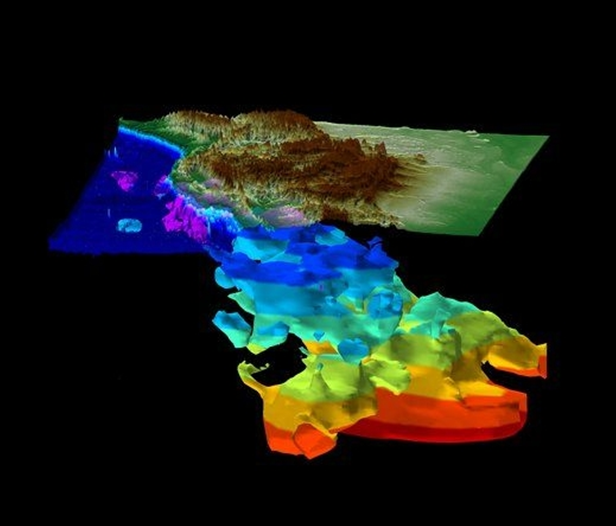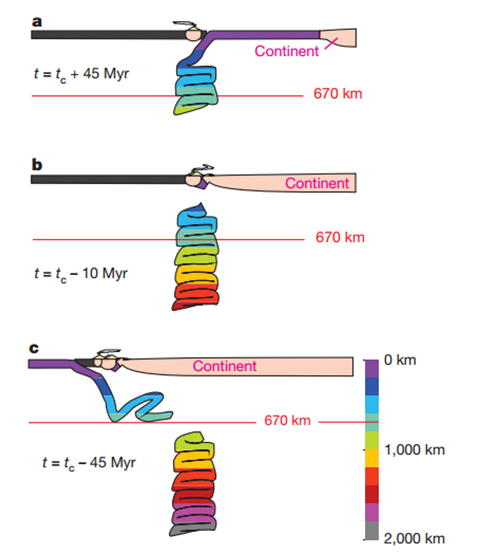
Kīlauea's East Rift Zone lava flow remains active upslope from the Pahoa Marketplace area, visible at upper left, though activity has waned over the past week. The flow was very close to a firebreak road cut several months ago. The Pahoa Transfer Station is at upper right. The view is to the Southeast. Photo taken Monday, December 22, 2014 courtesy of USGS/HVO
(Volcano Watch is a weekly article written by scientists at the U.S. Geological Survey's Hawaiian Volcano Observatory.)

Thirty feet (10 m) thick aa flow approaching the Sapienza barrier at Mount Etna. The flow add a layer about 6 feet (2 m) thick to the top of the barrier but did not go beyond. Photograph by Jack Lockwood, U.S. Geological Survey, May 28, 1983.
In discussions about lava diversion, Italy and Iceland are often touted as places where lava flows have been successfully diverted. But what did it take for those efforts to succeed?
With the eruptions in Italy and Iceland, successful slowing or diversion of the lava flows required costly and time-consuming efforts for months at a time. The successes were not the result of building just one barrier, breaching just one lava tube, or spraying water on a lava flow for only a few days. Each required multiple and/or continuous efforts that lasted for as long as the eruptions produced threatening lava flows.
Importantly, none of these eruptions threatened populated areas for more than a few months. Would the outcome have been different had the eruptions produced threatening lava flows for many years? This unanswered question is the source of debate when declaring lava diversion a success.
As with many success stories, the devil is in the details. So, using the 1991-1993 Mount Etna eruption as our first example, we will look at the details of what it took to successfully divert the lava.

Lava diversion was successful during the 1983 eruption. Photograph of the Sapienza barrier by Jack Lockwood, U.S. Geological Survey, May 29, 1983.
On December 14, 1991, Etna began erupting, sending lava toward the town of Zafferana Etnea, located 9 km (6 mi) downslope of the active vents. On January 1, 1992, workers began constructing a 234 m-long (256 yd-long), 21 m-high (69 ft-high) barrier about 2 km (1.2 mi) above the town. But on January 9, the lava flow front stalled and activity became focused upslope. By early March, another lobe of lava passed the original stalled front, reached the barrier on March 14, and overtopped it by April 10.
The barrier had successfully delayed the lava for a month, but flows continued to threaten Zafferana, and the population prepared for evacuation. Three more short barriers were built to slow the lava flow's advance, but they, too, were overtopped.
Meanwhile, plans for a different kind of lava-control project were enacted farther upslope. Per this plan, explosives were used to open up the feeder lava tube in an attempt to slow the flow's advance. After four unsuccessful attempts, the lava was successfully redirected into an artificial channel in late May. Robbed of its supply, the flow advancing toward Zafferana stalled.
By June 1992, the eruption rate had decreased by half and lava flows were only active upslope. Lava was no longer threatening Zafferana and efforts to slow or divert the lava were no longer required. The eruption ended in March 1993, after 16 months of volcanic activity and about 5 months of work to control the flow.

Sandey and Lóðsinn pumping sea water onto the forward margin of the lava at the breakwater (Photograph courtesy of Sigurgeir Jónasson, March 1973).
Our second example focuses on the 1973 Icelandic eruption. In January 1973, Eldfell volcano on the island of Heimaey erupted an 'a'ā lava flow. Over the next 5 months, billions of gallons of seawater were pumped through an elaborate network of pipes laid out across the lava to cool the flow and slow its advance toward Heimaey's only harbor, the lifeline of the island and a critical economic resource for the entire country. The fragmental nature of the lava flow's surface allowed the seawater to penetrate deep into the flow and cool the lava near its core, and the advance of the flow was slowed as the flow front thickened dramatically.
The eruption ended before the lava flow inundated the harbor, but the diversion effort required round-the-clock maintenance of the pipe and pump network until the eruption stopped in July
Lava diversion in Hawaiʻi is obviously a complex legal, political, technical, and cultural issue. One of the main technical issues is timing, which was so important in Iceland and Italy. Kīlauea's ongoing eruption will enter its 33rd year on January 3, and there are no signs that it will end anytime soon. Any diversion efforts may therefore need to be maintained for, potentially, years to decades—timescales over which diversion has never been attempted anywhere on Earth! And history has taught us that such efforts may only be successful in delaying the inevitable, as was the case in Kapoho in 1960.
Dialogue about how to cope with Kīlauea's July 27th flow is healthy and important, but should be done in full awareness of how lava flows in Hawaiʻi work, and the conditions under which previous lava flow slowing or diversion efforts have been successful (or not). Only with this knowledge can our elected officials, guided by an informed public, make decisions about how to respond to lava flows—hazards that have been a part of life in Hawaiʻi since the first Polynesians settled the islands, and that will continue to be prevalent for centuries to come.

